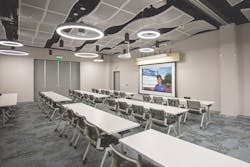Edward C. Little Water Recycling Facility
Bob Crossen is senior managing editor for WWD. Crossen can be reached at [email protected].
When it comes to enumerating water’s value, the Edward C. Little Water Recycling Facility has been developing the tools to educate, entertain and engage Los Angeles residents about water for more than 20 years, while also producing a drought-proof source for local communities.
Patrick Sheilds is the general manager of West Basin Municipal Water, which operates the plant, and he said the Edward C. Little facility, located in El Segundo, California, was commissioned in 1995. Initially it recycled 20 million gallons of water per day (mgd) with 15 mgd dedicated to paying users—namely industry and agriculture. The remaining 5 mgd are dedicated to the West Coast Basin Seawater Barrier and the Dominguez Gap Barrier.
These seawater barriers amount to a 9-mile stretch along the coast of Los Angeles and include 153 wells, all aimed at preventing seawater intrusion into potable groundwater aquifers. The water that El Segundo Water Recycling Facility produces for these barriers—along with other similar facilities in Los Angeles—has to meet strict, specified standards. For years, it had been imported drinking water, but now the facility treats recycled water for this purpose and still meets the drinking water standards for it.
“We’re always looking to replace applications where drinking water was formerly used, and now we use highly treated recycled water,” Sheilds said. “In the case of the barrier water, we use ultrafiltration, ozonation, microfiltration, then reverse osmosis, then peroxide dosing then ultraviolet radiation. And then some water conditioning and chlorination. It’s essentially drinking water standards.”
But that water is only one of five types produced at the Edward C. Little facility, as it produces disinfected tertiary water, nitrified water, low pressure boiler water and high pressure boiler water in addition to the barrier water.
Designing Water by Application
The facility uses advanced treatment equipment to handle the incoming water it receives from the Hyperion Water Reclamation Plant in Los Angelesn to produce its five types of water. Initially, treatment used was simple. The facility ran the influent through a lime clarifier to create barrier water in the 90s. That, however, has seen considerable updates in the past 25 years.
It started with microfiltration as a pre-treatment for reverse osmosis (RO). Then in 2006, when the facility added 5 mgd to its barrier water production, it introduced ozone as a pretreatment to microfiltration, which in turn is pretreatment for RO.
“The water we get from Hyperion is not really the best quality—it meets standards for ocean discharge in a 5-mile outfall—but when you’re introducing it to membranes, it needs considerable conditioning,” Sheilds said. “Its organics, ammonia and TSS is really high and at times TOC can be very high, so that can foul membranes very, very quickly.”
Ozone, he said, was the facility’s means of addressing those quality issues. Sheilds said the process is energy intensive and noted operators are careful to use this treatment option properly so as not to break down compounds in TOC to the point it can then pass through the microfilters.
Following the ozonation update, Sheilds said the Edward C. Little Water Recycling Facility added polyvinylidene difluoride membranes and produced another 5 mgd for the seawater intrusion barrier in addition to what it had already committed. This facility, he said, is among the first of its kind and has been a model for others like it.
“We’re considered, kind of pioneers, because we came and blazed the trail,” Sheilds said. “Some folks were doing one type of recycled water or one purpose as an offshoot of the permit requirement. We went in full tilt looking at all applications and then designed parts of the treatment process around those needs.”
With its capabilities to provide this variety of water, Sheilds noted it can adjust some of the water produced depending on the contractual obligation. For example, he said, industrial users look for ammonia-free water while agricultural users prefer to include ammonia.
Public Outreach
Naturally, the Edward C. Little Water Recycling Facility is a critical piece in providing a drought-proof water resource for El Segundo and Los Angeles, which are prone to dry spells and lack of rain.
“Now with climate change, we are subject to increasingly more severe droughts, longer droughts,” Sheilds said. “Recycled water is a reliable source for suitable applications.”
While the water it produces is not for direct potable use, Sheilds noted that providing recycled water opportunities means the community is not spending its potable water for irrigation or industrial applications.
Beyond providing this resource, the facility also developed outreach programs to teach the community about what it does and how it impacts the daily lives of people in the community.
When commissioned in 1995, the facility built a Water Education Center (WEC), which Sheilds said has been wildly popular. It has since undergone renovations with a grand re-opening in October 2019.
The updated facility now features up-to-date education information and interactive exhibits for visitors of all ages. More than 100,000 school children and college students have visited the center since its opening in the 90s.
“People are wanting to do conferences, colleges want to bring their kids over, [and] we have school programs. We have more than 3,000 kids signed up for next year already,” Sheilds said. “From the board, it’s been a policy decision to educate the public in terms about water conservation. Now we’re talking about climate change and the role of recycled water.”
Regardless of the topics, he said people will continue to visit, and he is happy to play a role in demonstrating water’s value.
